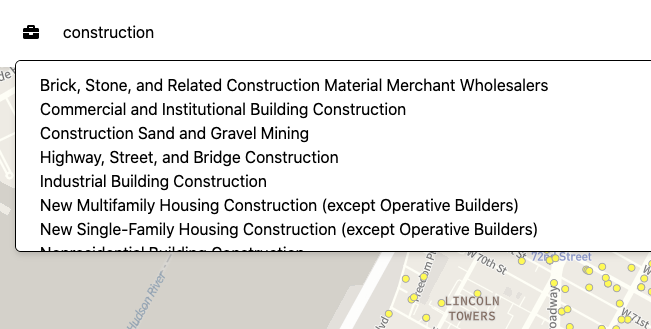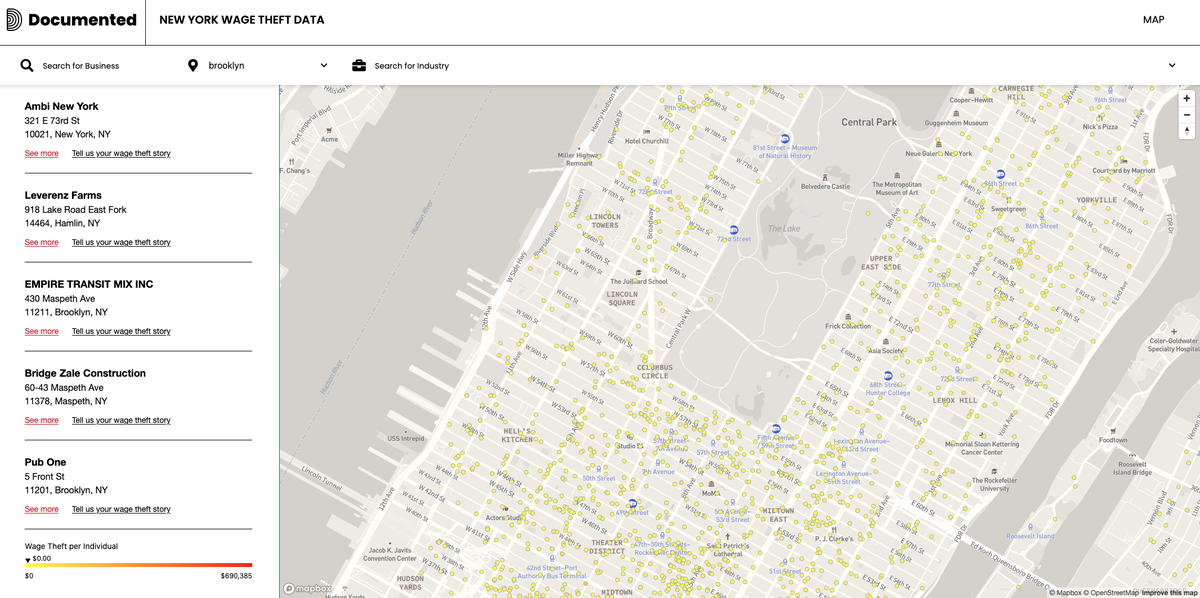In August, Documented published the most complete repository of data on New York companies who have stolen wages from their workers that currently exists. It was the product of nearly five years of work, starting with a freedom of information request filed back in September 2019.
Documented is a nonprofit news organization based in New York City that covers the City for its immigrant communities. Advocates had long explained to us that wage theft is common in industries staffed by undocumented immigrants. Which businesses had stolen money from their workers, and how much money was being recovered, were both unclear. Those questions are what this project sought to answer.
Also Read: Documented Launches The Wage Theft Monitor
Eventually, we secured data that helped us examine this issue in more depth than had been done before. We found that some of the most iconic New York City businesses had stolen hundreds of thousands of dollars from their employees. Entire industries were seemingly supported by the abuse and exploitation of workers. From one dataset, we’ve already been able to report multiple stories about wage theft, as have other newsrooms. We are hoping to expand this tool to be useful to local reporters all over the state.
How we got the data (after a fight)
In March 2019, I traveled with Mazin Sidahmed, the co-founder and co-executive editor of Documented, to Port Chester, New York, to meet with Gonzalo Cruz, the program coordinator of the worker advocacy organization Don Bosco Workers. He had invited us up to learn about the center’s work and labor issues in the local community.
The center is run from a small church in the town, which is north of New York City. In his office, Cruz showed us papers from investigations they had done into local wage theft cases. Labor advocates will sometimes investigate cases of wage theft and go directly to the employer, trying to settle the matter outside of the lengthy New York Department of Labor complaint system and expensive courts. Gonzalo pulled out two judgments from the Connecticut Department of Labor against the same business—the judgements had been roughly a year apart from each other, and it was clear the business owner had not been dissuaded from cheating workers. That got me wondering: What would have happened if the second worker had known about the first case of wage theft? Would that have changed anything?
I began researching what data was available on New York’s wage-stealing businesses. The federal Department of Labor regularly publishes data on its investigations, but the majority of the wage-theft investigations are run through the state DOL. In order to really understand what was happening on the ground, I had to get their data as well. I began searching for successful Freedom of Information Law (what the local access to information law is called) requests that other organizations had filed previously. Eventually, I pulled together enough information to file a request that I thought would encompass all of the data I was seeking.
After a failed first attempt, I recalibrated the request and sent it back in. After a couple of rounds of letters informing me that the DOL would need more time, we decided to sue on grounds of constructive denial, the legal term for denying an information request by endless delays.
Going into this project, I expected the DOL would be interested and even potentially help facilitate the production of this data. The amount of money that businesses have stolen from their workers is not secret or protected information. As we said in our lawsuit, the federal government freely offers up this information. It is valuable for workers, journalists, and the public.
We quickly learned that the DOL would not be a willing partner. It took us a year of negotiation before we got the first tranche of data. Later, we would learn that the data was incomplete. That set us back again, and we spent months negotiating further with the DOL to finally get the full dataset: a full count of all the DOL’s closed cases from 2005 to 2022. It is important to underscore how critical our legal counsel was in this process. Without lawyers from Cornell Law School’s First Amendment Clinic, it is likely we never would have received the data. They advised us on legal arguments and freedom of information issues and also served as a liaison between Documented and the DOL.
The tool we made (and what to know if you make one, too)
The data we received from the state provided the basics of each case: a rough time frame, the amount of dollars deemed stolen, penalties for workplace violations, address of the company, its industry, and a basic outline of its wrongdoing based on the labor violations it had committed. The federal dataset had a similar organization structure and fields, but with some key differences between date definitions. Had Agnel Philip, our partner data reporter, not caught this, we would have run the risk of a less accurate analysis. It is imperative to really understand the system each agency is using to track the data when combining two data sets.
In order to understand how to portray the information, we had to think about how people would use it. Our goal was for the data to be useful and accessible for reporters, professionals in the space, New Yorkers generally, and workers most likely to have their wages stolen. Wage theft can be difficult to track in part because of the nature of work in the City. Sometimes workers only know where the jobsite is, not who they are working for. Some companies will tell the workers one name and another will appear on their paycheck. App workers might never visit a physical site, and instead their work life exists entirely online. For these reasons and others, we decided to plot out all our points on a map, but also include a text search feature.

The first step in this project was understanding the local wage theft recovery infrastructure. In New York, many different agencies are working to address this issue. New York City’s district attorneys, state Department of Labor, federal Department of Labor, Attorney General, city comptroller, and state comptroller all touch on this issue. Many wage theft matters are settled through the civil court system, others just by informal mediation. It is nearly impossible to systematically gather the full spectrum of cases. We chose to target the agency that holds the highest volume of data: the state DOL. While it is helpful to have the federal data at hand, the vast majority of the data came from the state, and if a worker files a wage theft claim, it most likely would go through the state agency.
Each state has a labor agency working to tackle this issue, some stronger and more active than others. Should you seek to create a Wage Theft Monitor in your own state, the first step is to figure out which agency holds the data. The next is to try to piece together what sort of internal monitoring system it uses to keep track of its cases. The argument that the federal government makes the data available, so the state should too, was essential to our court case. It is likely that would help in other jurisdictions, but each state has unique labor laws. It makes sense to contact a local freedom of information specialist through groups like the Cornell Law School First Amendment Clinic or Reporters Committee for Freedom of the Press.
But perhaps the most important, expensive, and difficult task was staying persistent. More than three years passed from the day I filed the first request to the day we received the final tranche of data. Much of the time was waiting, but I spent many hours on the phone with our lawyer at Cornell and the DOL trying to get the documents released. You need to be willing to chip at getting this data year over year. Once you get it, though—and understand how to keep getting it—you will build a powerful and important tool.
A powerful tool for even more reporting
We have just begun to understand the reporting potential of this data. Labor experts will often tell you that wage theft is just one indicator of a workplace that can be dangerous or violent. Our data has surfaced numerous leads and story ideas that we have just begun to report on. I found a substantial case of wage theft at one nursing home and asked a reporter to poke around—he found ample evidence of violence, open drug use, and abuse in the facility. We believe this data can reveal an enormous amount about what is happening behind closed doors in our communities.
It can also be a force multiplier for your organization’s impact. At Documented, our reporters only have so much capacity for stories outside the news cycle. Our Wage Theft Monitor however, can be a font for stories from reporters across the state.








